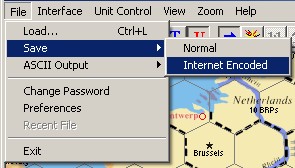
Saving a Game

Selecting "Save" from the project menu allows you to save the current game position and the playback for the turn to a saved game file. This file may then be sent to your opponent, if he's also a WGP user. If your opponent is not a WGP owner, you may still send your move using the save as ASCII functions.
The save game event will be recorded in the playback history. When the file is replayed, the viewer will be notified at the point where the game was saved during play. This is to discourage the practice of saving a game right before a critical die roll, then reloading and re-throwing the die until a desirable result is attained. If you're going to save a game in the middle of your move, it's good manners to leave a comment saying why you saved the game.
I've found it's helpful to agree on a naming system with your opponent that will help keep saved game files in order. For instance, you may wish to name the first move of the first turn of a Third Reich game as "390301", which would translate as 1939, third season (fall), first file exchange. This will result in all your turns being kept in order in your directory listings. You may also wish to keep your games separate in your directory listings by making subdirectories for each game in your savedgames directory.
Internet Encoded

This function is identical to the "Save Game" selection, except that the file will be encoded in standard ASCII characters suitable to be sent as attached e-mail over the Internet. If you and your opponent are able to attach binary files to your e-mails, you should not use this type of save. This feature was implemented in the 1990's when e-mail handlers were pretty primitive, and probably has no real application today.
Many old internet servers such as Juno or Genie would not support a binary transfer as e-mail. Others will allow you to attach a file to e-mail, but only if that file is strictly ASCII characters. This feature of WGP allows you to save the game in a format compatible with any e-mail handler. To use it, save the file using the "Encode Save" menu option. Once the file is saved, you should copy the text from the file you save to and paste it into your e-mail body text. Do not attach it as a binary file to your e-mail (If you are able to do this, just use the "save as normal" mode).
This sort of saved game file is normally twice as large as a standard saved game file. It consists of a WGP file header identifier, the saved game body, and the WGP file trailer. You should be careful not to add or change any text in any part of this file if you add it as E-mail. The saved game body consists of a block of encoded characters, 60 spaces wide. You will notice that the characters are alternating numbers and letters. WGP will be able to decode these during the load back into a normal saved game file format.
You may add text before or after the WGP file in your e-mail. The load function will ignore any text before the WGP file header. It will also ignore whatever line feed sequence your particular program uses, so if you use a PC or Mac to transfer your files, WGP should still be able to decode them.
Some e-mail servers impose a size limit on email text. You may have to break up your saved game files into two or more parts. Be sure to label them so that the other player can reassemble the parts into one file.
Copyright © 2010, Sean Emerson
Created with the Freeware Edition of HelpNDoc: Easily create Help documents